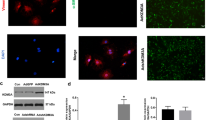Summary
Bcl6, a critical pro-oncogene of human B-cell lymphomas, can promote tumor progress. Previous studies have found that Bcl6 participates in hypoxia injury in cardiomyocytes. However, the effect of Bcl6 on cardiac fibroblasts is still unclear. The aim of this study was to elucidate the functional role of Bcl6 in cardiac fibroblast activation and function. The neonatal rat cardiac fibroblasts were isolated and cultured. First, transforming growth factor ß1 (TGFß1) was used to stimulate fibroblast activation. A decreased expression level of Bcl6 was observed in fibroblasts after stimulation with TGFß1. Then, cells were transfected with adenovirus Bcl6 to overexpress Bcl6. The results showed that Bcl6 overexpression induced decreased proliferation and reduced activation of fibroblasts which were stimulated with TGFß1. It was found that activated smad2 and smad3 were not changed by overexpressing Bcl6, but smad4 was decreased. Furthermore, co-immunoprecipitation results showed that Bcl6 directly bound to smad4, and induced down-regulation of smad4. At last, smad4 activator could counteract the anti-fibroblast effects of Bcl6. In conclusion, Bcl6 may negatively regulate cardiac fibroblast activation and function by directly binding to smad4.
Similar content being viewed by others
References
Ma ZG, Yuan YP, Wu HM, et al. Cardiac fibrosis: new insights into the pathogenesis. Int J Biol Sci. 2018,14(12):1645–1657
Frangogiannis NG. Cardiac fibrosis: Cell biological mechanisms, molecular pathways and therapeutic opportunities. Mol Aspects Med, 2019,65:70–99
Li L, Zhao Q, Kong W. Extracellular matrix remodeling and cardiac fibrosis. Matrix Biol, 2018,68–69:490–506
Al Hattab D, Czubryt MP. A primer on current progress in cardiac fibrosis. Can J Physiol Pharmacol, 2017,95(10):1091–1099
Leeman-Neill RJ, Bhagat G. BCL6 as a therapeutic target for lymphoma. Expert Opin Ther Targets, 2018,22(2):143–152
Cardenas MG, Oswald E, Yu W, et al. The Expanding Role of the BCL6 Oncoprotein as a Cancer Therapeutic Target. Clin Cancer Res, 2017,23(4):885–893
Wei Z, Gao W, Wu Y, et al. Mutual interaction between BCL6 and miRNAs contributing to the pathogenesis of various cancers. Clin Transl Oncol, 2015,17(11):841–846
Yoshida T, Fukuda T, Hatano M, et al. The role of Bcl6 in mature cardiac myocytes. Cardiovasc Res, 1999,42(3):670–679
Altieri P, Spallarossa P, Barisione C, et al. Inhibition of doxorubicin-induced senescence by PPARdelta activation agonists in cardiac muscle cells: cooperation between PPARdelta and Bcl6. PLoS One, 2012,7(9):e46126
Gu Y, Luo M, Li Y, et al. Bcl6 knockdown aggravates hypoxia injury in cardiomyocytes via the P38 pathway. Cell Biol Int, 2019,43(2): 108–116
Bhandary B, Meng Q, James J, et al. Cardiac Fibrosis in Proteotoxic Cardiac Disease is Dependent Upon Myofibroblast TGF-p1 Signaling. J Am Heart Assoc, 2018,7(20):e010013
Goh KY, He L, Song J, et al. Mitoquinone ameliorates pressure overload-induced cardiac fibrosis and left ventricular dysfunction in mice. Redox Biol, 2019,21:101–100
Pattar SS, Fatehi Hassanabad A, Fedak PWM. Targeting selected extracellular matrix components to attenuate cardiac fibrosis. Ann Transl Med, 2018,6(Suppl 1):S49
Hu S, Cao B, Zhang M, et al. Epigenetic silencing BCL6B induced colorectal cancer proliferation and metastasis by inhibiting P53 signaling. Am J Cancer Res, 2015,5(2):651–662
Li Y, Zhang X, Yang Z, et al. miR-339-5p inhibits metastasis of non-small cell lung cancer by regulating the epithelial-to-mesenchymal transition. Oncol Lett, 2018,15(2):2508–2514
Felisbino MB, McKinsey TA. Epigenetics in Cardiac Fibrosis: Emphasis on Inflammation and Fibroblast Activation. JACC Basic Transl Sci, 2018,3(5):704–715
Wu QQ, Ni J, Zhang N, et al. Andrographolide Protects against Aortic Banding-Induced Experimental Cardiac Hypertrophy by Inhibiting MAPKs Signaling. Front Pharmacol, 2017,8:808
Jiang XH, Wu QQ, Xiao Y, et al. Evodiamine Prevents Isoproterenol-Induced Cardiac Fibrosis by Regulating Endothelial-to-Mesenchymal Transition. Planta Med, 2017,83(9):761–769
Wang D, Long J, Dai F, et al. BCL6 represses Smad signaling in transforming growth factor-beta resistance. Cancer Res, 2008,68(3):783–789
Author information
Authors and Affiliations
Corresponding author
Additional information
Conflict of Interest Statement
The authors declare that they have no competing financial interests.
Rights and permissions
About this article
Cite this article
Ni, J., Wu, Qq., Liao, Hh. et al. Bcl6 Suppresses Cardiac Fibroblast Activation and Function via Directly Binding to Smad4. CURR MED SCI 39, 534–540 (2019). https://doi.org/10.1007/s11596-019-2070-y
Received:
Revised:
Published:
Issue Date:
DOI: https://doi.org/10.1007/s11596-019-2070-y




